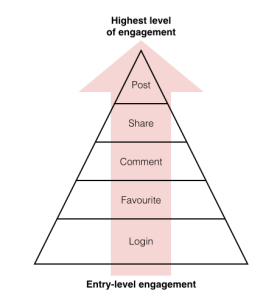One of the first blog posts that Boris shared with me when I was starting…
Data / AI / ML, Entrepreneurship
Back in 2014, I blogged about building a user engagement pyramid for social platforms, inspired by Fred Wilson’s 100/10/1 rule. The premise of that post was simple: since user-generated content is king, the top of the pyramid (aka the most engaged users) are those who post status updates, photos and links. And, these creators are inspired when […]
One of the first blog posts that Boris shared with me when I was starting…
At Version One, we love marketplaces and platforms. Over 50% of our portfolio companies fall…
Back in 2014, I blogged about building a user engagement pyramid for social platforms, inspired by Fred Wilson’s 100/10/1 rule.
The premise of that post was simple: since user-generated content is king, the top of the pyramid (aka the most engaged users) are those who post status updates, photos and links. And, these creators are inspired when they are recognized for their contributions via shares, comments, and favourites. As such, the user engagement pyramid should look something like below and the goal of social networks is to move users up the pyramid.

In that original post, I offered two non-mathematical steps for creating an engagement pyramid:
A few months ago, one of our founders reflected on this advice, “Conceptually, this is all good but is there a ‘scientific’ method of building this hierarchy of engagement?” As a lover of all things data, these comments inspired me to revisit the post and see if I could add a more solid mathematical framework to the pyramid.
Upon further reflection, I think the first point about placing your most engaged activity up top is still valid. However, for point 2, I think that friction (as measured by how hard/easy an activity is) may not be the most important factor for determining engagement. Here’s why:
Individual vs. Systematic Engagement
Let’s consider the following: is the user who logs on everyday and simply lurks more or less engaged than the user who only logs in once that month but posts content?
On a purely DAU/MAU basis, the former is more engaged than the latter. However, there is a difference between the individual’s engagement and “systematic” engagement (how the individual’s actions influence all other actions of the platform). The pyramid above represents the latter because posting content, in theory, will attract more people to the platform than just lurking or liking. In other words, posting has higher systematic engagement than logging in.
It’s a nuanced distinction, but important to understand.
Can we create an index for engagement?
If we revisit point #1, there’s some low-hanging fruit to help us figure out individual engagement:
These two exercises should inform what the systematic engagement pyramid looks like. Most likely, you already have a strong intuition of what action should be on top and this exercise is just a matter of testing your hypothesis.
Here’s an example. Let’s say you believe that posting an image engages the most users. How do you test this to be true? You’ll need to take a step back and define the influence or reach of a given action.
In this case, the engagement “index” of an image can be computed as:
# of likes + # of comments + # of shares + # of views
Likewise, the engagement index of a comment is:
# likes + # of views
Simply put, think of the pyramid as ranking the potential reach of all users. Every step down the pyramid has a smaller reach. Based on the above, the reach of an image is greater than the reach of a comment. You can assign value to every possible user action (posting a status update, sharing a link, etc.) and then rank the actions according to total potential value.
Keep in mind, that your index will be more complex, as I made a lot of assumptions on linearity for simplicity’s sake.
Key takeaways
What can we take away from all this? First, systematic and individual engagement are two different things: systematic engagement is a function of all individual engagement combined. It’s important to understand this distinction when building your engagement pyramid. Second, for as much as we try to quantify engagement, this process is still very much more art than science.
And please, keep the comments coming. Each discussion further refines the model and helps us all.
Portfolio
It’s been an eventful quarter (when has it not?), and somehow we’ve already crossed the halfway mark of 2025. We wanted to take a moment to highlight just a few of the wins, milestones, and momentum we’ve seen this past quarter. As always, there’s a whole lot happening behind the scenes that can’t be shared […]
The V1 family kicked off the new year with fresh energy and no shortage of…
At the end of Q1, we anticipated that a tech sector slowdown is ideal for…